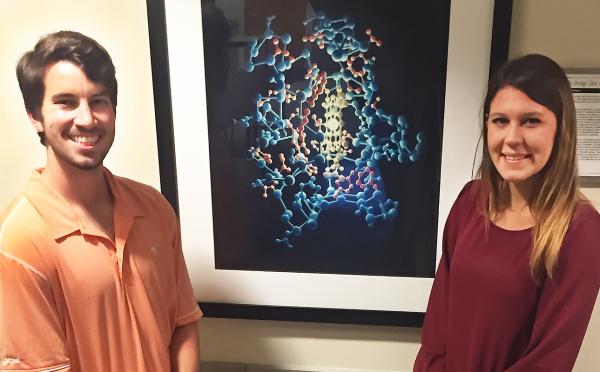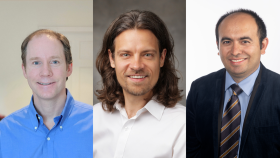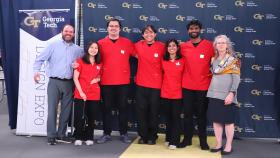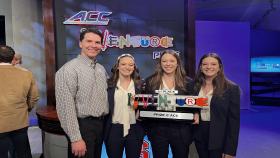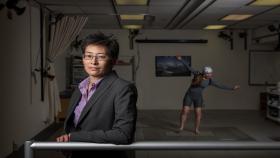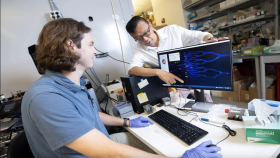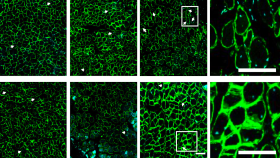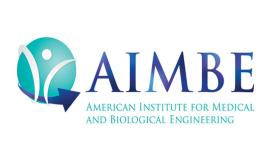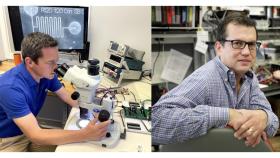Kaci Crawford and Cory Turbyfield have learned very quickly that what you say truly matters, especially when you know what you’re talking about. The pair of undergraduates from the Wallace H. Coulter Department of Biomedical Engineering (BME) recently took first place for Best Oral Presentation in the 10th annual Undergraduate Research Spring Symposium at the Georgia Institute of Technology.
Crawford and Turbyfield presented research from their project, called, “Biomechanical comparisons of leukemia cells and their healthy counterparts,” which focused on using a microfluidic chip to separate leukemia cells from healthy white blood cells.
“The clinical impact of this project has the potential to shift the diagnostic protocol from a bone marrow biopsy, which is what is typical now, and is very painful, to a simple blood sample,” explains Crawford, who has also joined with Turbyfield to start a biomaterials testing company through what they’ve learned as undergraduate researchers in the lab of Todd Sulchek, faculty member of the Parker H. Petit Institute for Bioengineering and Bioscience. Their company, Vesalius Technologies, LLC, was incorporated in January.
“Cory and I have been working on characterizing disease in a different way,” Crawford says. “In the past, we’ve seen healthy cells and diseased cells being distinguished from each other based on what genes they express, or what proteins they are producing. So this could mean differences in things like what biomolecules are present on the cell’s surface, or what structurally is different about a diseased cell. Does it have a different cellular “skeleton”? Did it shrink in size?
This type of information is definitely helpful and relevant, but until very recently, it’s been the only information we’ve had.”
She continues, “Our lab is focusing on adding a new piece of information to the picture. We measure mechanical properties of cells, and then compare the differences we see in the healthy versus the unhealthy. The explicit mechanical properties we study are stiffness and viscoelasticity, as well as compare size measurements. If people aren’t familiar with viscoelasticity, we’re using it here to describe the rate at which a cell can regain its shape after it is compressed.”
They measure these properties with a technique called Atomic Force Microscopy (AFM). These two BME students have become experts in this difficult skill, so
Sulchek, an assistant professor based in the Woodruff School of Mechanical Engineering, suggested they start a company. Vesalius Technologies will provide measurements that can used “for anything from FDA regulations to patent law infringement legal cases,” according to Crawford.
In their study, the students proved there were differences in the mechanics between healthy and cancerous cells, using a microfluidic chip (‘lab on a chip’) the Sulcheck lab had developed to separate cells. “We knew if we flowed a sample containing cancerous cells through the chip, we should be able to isolate stiffer, healthy cells from softer cancerous ones,” Crawford says. “This is revolutionary in terms of diagnostics. Using this technology, we are able to envision a day where you go to the doctor and find if you have cancer from a blood test.”
Crawford and Turbyfield plan to continue their studies this summer, using blood samples from patients with leukemia. They also want to grow their company. All of it, they both agree, has been made possible through the professional connections, hands on experience, and entrepreneurial focus at BME.
“The best part about the biomedical engineering program here at Tech is the fact that it is always evolving,” Turbyfield says. “The professors and administrators are always on the look out for new and better ways to teach and support the students that make up this department. It is reassuring to know that you are part of a program that cares so deeply about your success as an individual.”
In addition to their award at the symposium, and their recently minted company, Crawford and Turbyfield are both PURA award recipients and have served as teaching assistants for BMED 2300, the Engineering Design class.
Ultimately, the wide-ranging BME undergraduate experience has opened doors of discovery and opportunity for these two, bringing them to the brink of uncharted territory. “Undergraduate research has been my best experience at Georgia Tech,” says Turbyfield. “I have had the opportunity to work on the fringe of cancer research with cutting edge technology and brilliant minds. Kaci and I are uncovering knowledge that was previously unknown to the world and it is beyond exciting.”
CONTACT Walter Rich
Communications Manager
Wallace H. Coulter Department of Biomedical Engineering
Georgia Institute of Technology
Media Contact
Jerry Grillo
Communications Officer II
Parker H. Petit Institute for
Bioengineering and Bioscience

